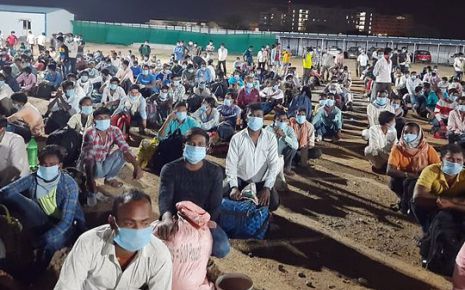Comparing Indian Workers' Social Security To International Labour Standards
The provision of Social Security to employees guarantees that they are
shielded from all risks and get additional benefits in addition to their pay and
compensation. It is a human right that gives employees access to social welfare
benefits and help for those who are unable to work due to any form of illness,
disability, etc. The right to maternity leaves, retirement benefits, and other
additional benefits are also granted to employees. Social security is intended
to help employees, raise their standards of living, and assure their welfare and
development.
The Code on Social Security, 2020 in India now governs workers' social security. The Social Security Code, which is comprised of several social security-related legislation, is the result of the code. Regarding international labour standards, the International Labour Organisation (ILO) has produced a number of conventions and recommendations that outline best practises for worker social security that are implemented all over the world and seek to establish a global standard for it.
For instance, the Social Security (Minimum Standards) Convention, 1952 (No. 102) (hereinafter referred to as Convention No. 102) established a minimum standard of benefits that must be offered to all workers and was divided into nine categories, including medical care, sickness, unemployment, old age, work injury, family, maternity, invalidity, and survivors' benefits. Other significant treaties pertaining to social security include the Social Protection Floors Recommendation, 2012 (No. 202), the Maintenance of Social Security Rights Convention, 1982 (No. 157), and others.
An obligatory insurance programme is established in India by the Employees' State Insurance Act, 1948, which covers sickness benefits, maternity benefits, disability benefits, medical benefits, etc. The legislation applies to all states and regulates factories and other enterprises with ten or more employees.
Conclusion
As we could see, India has adopted a large number of the clauses and tenets of the many agreements and recommendations pertaining to the social security of employees made by the International Labour Organization[34]. The Employees State Insurance Act[36], the Maternity Benefit Act[37], and other laws and regulations in India, such as the Code on Social Security[35], might all be used to demonstrate the same.
However, there are still numerous flaws in Indian labor laws, such as the fact that the majority of unorganized sector workers are unable to take use of these advantages and that workers are not aware of their rights. Therefore, there is still more work to be done to tighten our labor rules, but it is possible to do so with careful application of the existing laws and employee education.
The Code on Social Security, 2020 in India now governs workers' social security. The Social Security Code, which is comprised of several social security-related legislation, is the result of the code. Regarding international labour standards, the International Labour Organisation (ILO) has produced a number of conventions and recommendations that outline best practises for worker social security that are implemented all over the world and seek to establish a global standard for it.
For instance, the Social Security (Minimum Standards) Convention, 1952 (No. 102) (hereinafter referred to as Convention No. 102) established a minimum standard of benefits that must be offered to all workers and was divided into nine categories, including medical care, sickness, unemployment, old age, work injury, family, maternity, invalidity, and survivors' benefits. Other significant treaties pertaining to social security include the Social Protection Floors Recommendation, 2012 (No. 202), the Maintenance of Social Security Rights Convention, 1982 (No. 157), and others.
International Standards And Practices Followed In India
Medical Care Benefits
Every member who is subject to Convention No. 102 has the right to receive benefits for medical care, including expectant mothers and individuals with disabilities, according to the medical care requirements in Part II of the convention. The provisions of the aforementioned Convention also cover general practitioner treatment, hospitalization, the provision of drugs, etc. in the event of morbid illnesses, as well as prenatal and postnatal care throughout pregnancy. According to Section 39 of the Indian Social Security Code, an insured person or a member of his family is entitled to the same care if they require it. Furthermore, such a benefit might be given in the form of medical treatment in any hospital, clinic, or recipient's house.Sickness Benefits
The workers are entitled to periodic payment of their earnings, which must be at least 45 percent of the reference wages, under the terms of Part III of Convention No. 102, which addresses illness benefits. Any insured individual in India is entitled to periodic payment in the event of sickness, according to Section 32 of the Code, and he confirms this by presenting a medical certificate that is legally signed by the treating physician. Funeral expenditures are also covered under the section's sub clause g, which stipulates that they should be paid to the insured person's oldest relative or to anybody else who has incurred them.Unemployment Benefits
It is stipulated in Part IV of Convention No. 102,which provides that an individual may get employment benefits if they are unable to find stable job while having the necessary skills for employment. Although there is no formal law in India that guarantees unemployment payments, Section 2(78) of the Code defines social security and lists unemployment as one of the categories.Old-Age Benefits
Part V of Convention No. 102 specifies that employees shall receive old-age benefits and establishes a retirement age of no more than 65 years of age or higher. According to Section 2(70) of the Code of India, retirement is defined as the employee ending their employment after attaining the legal retirement age. In addition to this, other laws also provide provision for it. The Employees' Provident Fund & Miscellaneous Provisions Act, 1952, for instance, stipulates perks that a retiree may use, such as pensions or other benefits.Employment Injury Benefits
It is offered by Part VI of Convention No. 102, which gives benefits and medical attention to a person who was hurt at work. Additionally, it allows for monthly payment of at least 50% of the equivalent remuneration in the event that it has resulted in inability to work. It includes a morbid condition, an inability to work, and a loss of benefits incurred by a widow or her kid when the family's primary provider passes away as a result of an accident sustained at work.An obligatory insurance programme is established in India by the Employees' State Insurance Act, 1948, which covers sickness benefits, maternity benefits, disability benefits, medical benefits, etc. The legislation applies to all states and regulates factories and other enterprises with ten or more employees.
Invalidity And Survivors Benefit
The same is covered by Parts IX and X, respectively, of Convention No. 102. While workers who are permanently unable to work or engage in productive labor are given benefits for invalidity. Survivors' Benefits are offered to people who have lost the family's primary provider, such as the widow and her children. The Employees State Insurance Act and the Employees' Provident Fund and Miscellaneous Provisions Act over see the same in India.Conclusion
As we could see, India has adopted a large number of the clauses and tenets of the many agreements and recommendations pertaining to the social security of employees made by the International Labour Organization[34]. The Employees State Insurance Act[36], the Maternity Benefit Act[37], and other laws and regulations in India, such as the Code on Social Security[35], might all be used to demonstrate the same.
However, there are still numerous flaws in Indian labor laws, such as the fact that the majority of unorganized sector workers are unable to take use of these advantages and that workers are not aware of their rights. Therefore, there is still more work to be done to tighten our labor rules, but it is possible to do so with careful application of the existing laws and employee education.
Law Article in India
Legal Question & Answers
Lawyers in India - Search By City
LawArticles
How To File For Mutual Divorce In Delhi

How To File For Mutual Divorce In Delhi Mutual Consent Divorce is the Simplest Way to Obtain a D...
Increased Age For Girls Marriage

It is hoped that the Prohibition of Child Marriage (Amendment) Bill, 2021, which intends to inc...
Facade of Social Media

One may very easily get absorbed in the lives of others as one scrolls through a Facebook news ...
Section 482 CrPc - Quashing Of FIR: Guid...

The Inherent power under Section 482 in The Code Of Criminal Procedure, 1973 (37th Chapter of t...
The Uniform Civil Code (UCC) in India: A...

The Uniform Civil Code (UCC) is a concept that proposes the unification of personal laws across...
Role Of Artificial Intelligence In Legal...

Artificial intelligence (AI) is revolutionizing various sectors of the economy, and the legal i...








Please Drop Your Comments